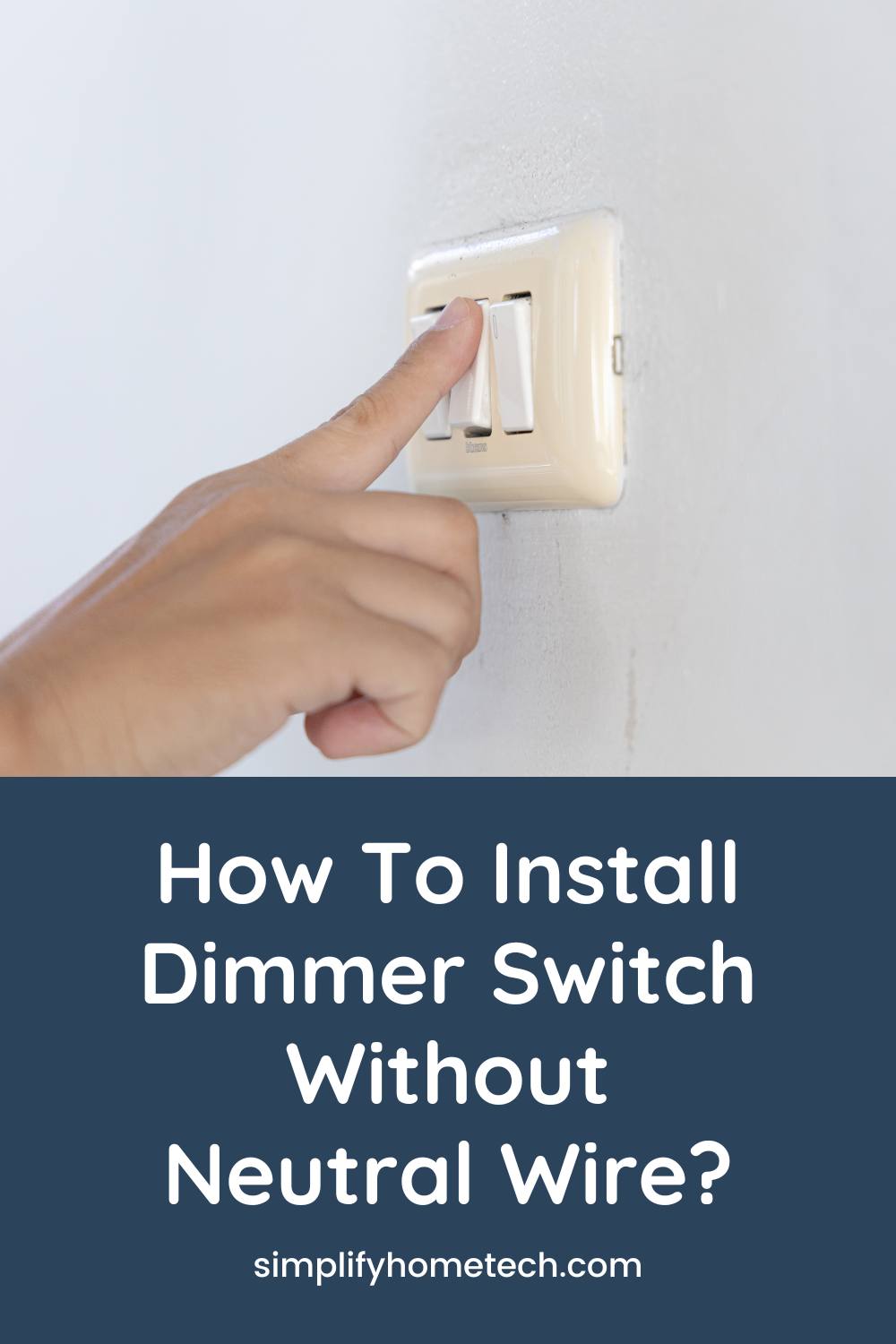Modern lighting isn’t just about brightening a room; it’s about setting a mood. Dimmer switches are one of the easiest ways to customize your lighting levels. However, if your home’s wiring doesn’t have a neutral wire — which is common in older homes — you might think installing a dimmer switch is off-limits.
Good news: it’s absolutely possible! In this detailed guide, you’ll learn everything you need to know about installing a dimmer switch without a neutral wire, the options available, key safety tips, and a full step-by-step installation guide.
What Is a Neutral Wire and Why It Matters
A neutral wire is a critical component of most modern electrical systems. It carries the unused electricity back to the breaker panel, completing the circuit. Most smart devices and modern dimmer switches rely on a neutral wire to function properly.
Without a neutral wire, some dimmer switches won’t have a complete circuit to draw minimal power when the light is off — a necessity for many electronic devices. That’s why finding the right type of dimmer switch is crucial.
Challenges of Installing Without a Neutral Wire
If you don’t have a neutral wire, you’re going to face a few specific challenges:
- Limited Product Choices: Many modern dimmer switches assume a neutral wire is available.
- Electrical Noise: Without a neutral, some dimmers can cause flickering or buzzing.
- Compatibility Issues: Certain types of bulbs (especially LED and CFL) are more sensitive without neutral wire setups.
- Increased Risk: Without the right dimmer, you risk overheating, circuit damage, or reduced bulb life.
But don’t worry — these challenges can be easily overcome with the right approach and products.
Best Types of Dimmer Switches for No-Neutral Setups
Not all dimmer switches are created equal. If you’re dealing with a no-neutral wiring situation, you need to look for a dimmer designed specifically for it.
Here are the best options:
1. No-Neutral Dimmer Switches
Some manufacturers produce dimmers explicitly for setups without neutral wires, often labeled “no-neutral” or “2-wire” dimmers.
Popular examples:
2. Switches with a Bypass
Some dimmers allow you to install a small bypass at the light fixture to trick the system into operating correctly without a neutral wire.
3. Electronic Low Voltage (ELV) Dimmers
These are often better suited for LED lights and older homes without neutral wiring. However, you’ll need to verify compatibility.
Tools and Materials You’ll Need
Before starting, gather the following:
- No-neutral compatible dimmer switch
- Flathead and Phillips screwdrivers
- Voltage tester
- Wire stripper
- Electrical tape
- Wire nuts
- Optional: Bypass device (if required by your dimmer)
Important: Always read the manufacturer’s manual that comes with your dimmer switch.
How to Install a Dimmer Switch Without Neutral: Step-by-Step
Now, let’s walk through the installation process.
Step 1: Turn Off the Power
Go to your home’s electrical panel and turn off the circuit breaker that controls the switch you are replacing. Always double-check by flipping the existing switch and using a voltage tester to confirm no electricity is flowing.
Step 2: Remove the Existing Switch
- Unscrew the wall plate.
- Gently pull the switch out from the electrical box.
- Identify and label the wires if necessary:
- Line (hot) wire
- Load wire (going to the light fixture)
- Ground wire
- You may not find a neutral wire — that’s normal.
Step 3: Disconnect the Wires
Unscrew the wire nuts or terminals and disconnect the old switch completely.
Step 4: Connect the New Dimmer Switch
Each no-neutral dimmer will have a slightly different wiring diagram, but the basic process looks like this:
- Connect the line (hot) wire to the dimmer’s line input.
- Connect the load wire to the dimmer’s load output.
- Attach the ground wire (usually green or bare copper) to the dimmer’s ground terminal.
- Skip the neutral terminal if your dimmer has one and your system doesn’t provide a neutral.
Tip: Twist wire nuts securely and wrap connections with electrical tape for extra safety.
Step 5: (Optional) Install a Bypass
If your dimmer needs a bypass device (sometimes called a “load resistor”), install it at the light fixture according to the instructions provided.
This ensures the dimmer gets enough power even when the light is turned off.
Step 6: Secure and Test
- Carefully push the wiring back into the box.
- Screw the dimmer into place.
- Attach the wall plate.
- Turn the power back on at the breaker.
- Test your new dimmer switch — both ON/OFF functions and dimming range.
Congratulations! You just installed a dimmer without a neutral wire.
Safety Tips You Can’t Ignore
- Always turn off power at the breaker, not just the switch.
- Use a voltage tester every time before touching wires.
- Double-check compatibility: Not all dimmers can work without neutral wires.
- Don’t overload the dimmer: Check its wattage rating against the total wattage of the lights connected.
- If unsure, call a professional: Electricity is not something you want to guess with.
Common Problems and How to Fix Them
Even after a successful install, you might encounter a few hiccups. Here’s how to fix them:
| Problem | Likely Cause | Solution |
|---|---|---|
| Lights flicker | Dimmer not compatible with bulbs | Use dimmable LEDs rated for your dimmer |
| Switch gets hot | Overloaded circuit | Reduce the number of lights or use a dimmer with higher wattage support |
| Buzzing noise | Incompatible bulbs or dimmer | Switch to better quality, dimmer-compatible bulbs |
| Dimmer doesn’t work | Incorrect wiring | Recheck connections carefully |
Should You Hire a Professional?
If you’re confident with basic electrical tasks like replacing light switches, you should be fine doing it yourself. However, hire a licensed electrician if:
- You find old, damaged, or confusing wiring.
- The dimmer installation involves multiple switches (like 3-way circuits).
- You’re uncomfortable working with electricity.
A professional ensures everything is safe, up to code, and properly configured.
Final Thoughts
Installing a dimmer switch without a neutral wire may seem tricky at first, but with the right products and careful attention to wiring, it’s entirely achievable for a determined DIYer.
Always prioritize safety. Invest in a high-quality no-neutral dimmer compatible with your lighting setup, and don’t rush through the installation. A few extra minutes spent double-checking connections and grounding wires can make all the difference between a successful install and a dangerous one.
By upgrading to a dimmer switch, you not only improve your home’s ambiance but also increase its energy efficiency — even without a neutral wire!
FAQs
Q1: Can all LED bulbs work with no-neutral dimmers?
A: No. Only dimmable LED bulbs rated for use with specific dimmer types will perform well. Always check bulb specifications.
Q2: Can I add a neutral wire instead?
A: Technically yes, but it usually involves major rewiring. Installing a no-neutral dimmer is faster and much cheaper.
Q3: Are smart dimmers available without a neutral wire?
A: Absolutely! Brands like Lutron Caseta offer smart dimmers designed specifically for no-neutral setups.
Q4: What happens if I connect a neutral wire incorrectly?
A: It can cause malfunction, circuit breaker trips, or electrical hazards. Always ensure proper connections or hire a professional.
Q5: How do I know if I have a neutral wire?
A: Open the switch box: if you find white wires grouped together and capped with a wire nut, that’s typically your neutral bundle.

